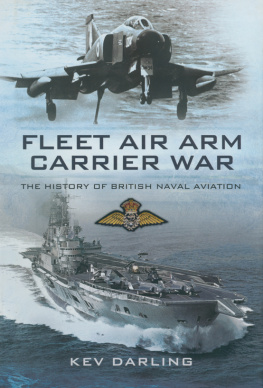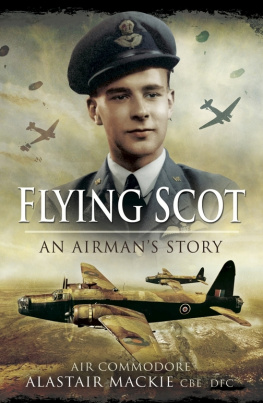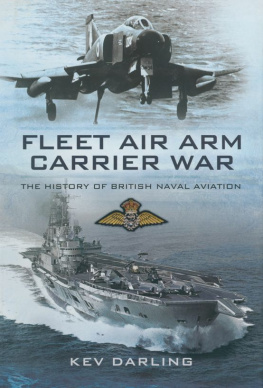Fleet Air Arm
Carrier War
FLEET AIR ARM
Carrier War
The History of British Naval Aviation
Kev Darling
First published in Great Britain in 2009 by
Pen & Sword Aviation
an imprint of
Pen & Sword Books Ltd
47 Church Street
Barnsley
South Yorkshire
S70 2AS
Copyright Kev Darling, 2009
ISBN: 978 1 84415 903 1
The right of Kev Darling to be identified as author of the work
has been asserted by him in accordance with the
Copyright, Designs and Patents Act 1988.
A CIP catalogue record for this book is available from
the British Library
All rights reserved. No part of this book may be reproduced or transmitted
in any form or by any means, electronic or mechanical including
photocopying, recording or by any information storage and retrieval
system, without permission from the Publisher in writing.
Typeset in Palatino by S L Menzies-Earl
Printed in the UK by MPG Books Group
Pen & Sword Books Ltd incorporates the imprints of:
Pen & Sword Aviation, Pen & Sword Maritime, Pen & Sword
Military, Wharncliffe Local History, Pen & Sword Select, Pen &
Sword Military Classics, Leo Cooper, Remember When, Seaforth
Publishing and Frontline Publishing.
For a complete list of Pen & Sword titles please contact:
Pen & Sword Books Limited
47 Church Street, Barnsley, South Yorkshire, S70 2AS, England
E-mail: enquiries@pen-and-sword.co.uk
Website: www.pen-and-sword.co.uk
Contents
D uring its entire existence the Fleet Air Arm, the aviation wing of the Royal Navy, has frequently suffered from political interference. Having literally got off to a flying start as the Royal Naval Air Service the Admiralty was most upset to find the worlds largest naval air wing being subsumed into the newly formed Royal Air Force in 1918. During the inter-war period the Royal Navy managed to hang onto its aircraft carriers although the aircraft it carried were under the control of the Air Ministry. Eventually the Admiralty managed to increase its influence over its own aircraft and the crews they carried. By the time hostilities erupted over Europe again in September 1939 the Royal Navy had fully regained control of both its ships and aircraft which, given the tasks that faced them, was the sensible option. Even though the Admiralty was now in control the major problems facing the carrier crews was the poor performance of the aircraft they were equipped with because they were designed for the warfare of a much earlier era. But, even though the fighter and attack units were equipped with obsolescent aircraft, through skilful flying and great bravery the crews managed to achieve some great feats of combat.
WWII brought a perilous period of existence for the Royal Navy when many of its fleet carriers were sunk. However, hasty conversions of merchantmen, the lend lease by America of the smaller escort, or jeep, carriers plus a speeding up of the building of replacement main and light fleet carriers meant that the navy was soon fully equipped again. Allied to the increase in carrier strength came a new crop of aircraft from both British and American manufacturers. With this new strength and the tide of war changing in the favour of the Allies the Fleet Air Arm and the aircraft carriers would finish their work in the Atlantic and then proceed into the Mediterranean and onto the Pacific and the war in the Far East. Here they would join up with the US Navy whose forces could only be described as massive.
When Japan finally capitulated in 1945 most people hoped that the threat of war would recede for many years. However, this was not the case as the power vacuum caused by the removal of conquerors and colonial powers would result in further conflicts. Again the Far East would figure greatly, this time it would be Korea where the Communists, both Russian and Chinese, would begin to flex their muscles. After nearly three years of fighting up and down the country a truce was finally achieved.
Nevertheless, Britain would find itself at war again in 1956 this time over the Suez canal which Egypts President Nassar decided to sequester. Although a combined British and French force, with Israeli support, was making great headway against the Egyptian forces, pressure by the United States via the World Bank resulted in the operation ending prematurely.
After Suez the Fleet Air Arm and the Royal Navy were active participants in the Cold War as was the remainder of Britains Armed Forces. This would change in 1982 when Argentina invaded the Falkland Islands in an effort to divert attention away from problems at home. After a massive effort the British Armed Forces successfully recaptured the islands. Again the Fleet underwent changes, this time the last of the vessels whose roots lay in the Second World War were finally retired and were replaced by three smaller carriers that were capable of operating both helicopters and Sea Harriers. Obviously machines as complex as aircraft carriers will eventually wear out so it is fortunate that the Royal Navy will receive the first of two new super-carriers within a few years. Not only will these new ships improve the capabilities of the fleet but the aircraft intended for deployment in these new vessels will also increase the effectiveness of the fleet. Should all this come to pass without too much political interference the future of the Fleet Air Arm looks good.
Obviously a work such as this could not be completed without the help of others therefore I would like to thank the staff at the Fleet Air Arm Museum, Yeovilton, Air Britain, the late and sadly missed Ray Sturtivant, John Ryan, Ray Harding and all at Aerophot.
Kev Darling, Wales 2009
Aviation for the Navy
From the Start to 1939
W hen Admiral Sir John Jackie Fisher, later Lord Fisher of Kilverstone, was returned as First Sea Lord in October 1914 at the age of 74, having retired for the first time four years earlier, he continued the process that speeded up the evolution of the Royal Navy, taking it to the pinnacle of its existence. It was only the requirements of the First World War and the forced retirement of the previous First Sea Lord, Prince Luis of Battenburg due to alleged German connections, that had seen Fisher recalled. His tenure of office ended on 15 May 1915 after a flaming row with Churchill over the Gallipoli campaign which Fisher strongly disagreed with. The irony of this was that Churchill also resigned when the campaign went disastrously wrong.
Contrary to the opinions of many critics that had been voiced strongly since the creation of the battleship fleet the Royal Navy was very much in favour of adopting emerging technology. However, they exercised some restraint until the technology was proven and thus numerous developments took some time to enter general naval service. Typical was the care taken over the deployment of breech loading guns, the gun turret and barbette to house them and the creation of hull forms and the finally revealed upper structures developed from these developmental evaluations. With Admiral Fisher in control, all of these developments plus others, such as the oil fired boiler and the turbine engine, came to fruition in the shape of the Dreadnought class battleship. Not only did this class of sea-going weapon render the remainder of the worlds fleets obsolete it instituted a global arms race with the British having the avowed intent of retaining the two power fleet. This standard was based on the idea that the soon to be named Grand Fleet should be stronger in numbers and firepower than the combined two numerically nearest fleets of the competing nations. While Fisher did reveal some strategic flaws, the best known being his support for the battlecruiser which mounted battleship guns over cruiser thickness armour, he was enthusiastic and supportive of other emerging technologies that could be of use to the Royal Navy in the future.
Next page












